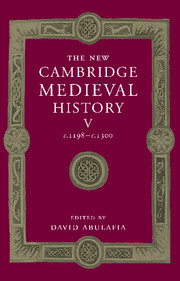Book contents
- Frontmatter
- Introduction
- Part I Common Themes
- Part II The Church in the Thirteenth Century
- 5 The papacy
- 6 The Albigensian Crusade and heresy
- 7 The Church and the laity
- 8 The Church and the Jews
- 9 The religious Orders
- 10 The universities and scholasticism
- Part III The Western Kingdoms
- Part IV Italy
- Part V The Mediterranean Frontiers
- Part VI The Northern and Eastern Frontiers
- Appendix Genealogical tables
- Primary sources and secondary works arranged by chapter
- Index
- Plate section
- Map 1 Europe in the thirteenth century
- Map 3 France, c. 1260
- Map 5 Germany and the western empire
- Map 6 Genoa, Venice and the Mediterranean
- Map 8 The Latin empire of Constantinople and its neighbours
- Map 10 Aragon and Anjouin the Mediterranean">
- References
9 - The religious Orders
from Part II - The Church in the Thirteenth Century
Published online by Cambridge University Press: 28 March 2008
- Frontmatter
- Introduction
- Part I Common Themes
- Part II The Church in the Thirteenth Century
- 5 The papacy
- 6 The Albigensian Crusade and heresy
- 7 The Church and the laity
- 8 The Church and the Jews
- 9 The religious Orders
- 10 The universities and scholasticism
- Part III The Western Kingdoms
- Part IV Italy
- Part V The Mediterranean Frontiers
- Part VI The Northern and Eastern Frontiers
- Appendix Genealogical tables
- Primary sources and secondary works arranged by chapter
- Index
- Plate section
- Map 1 Europe in the thirteenth century
- Map 3 France, c. 1260
- Map 5 Germany and the western empire
- Map 6 Genoa, Venice and the Mediterranean
- Map 8 The Latin empire of Constantinople and its neighbours
- Map 10 Aragon and Anjouin the Mediterranean">
- References
Summary
AROUND 1230, one of the greatest figures of the Reformation, the bishop of Acre, Jacques de Vitry, taking stock of the changes that had occurred to Christianity throughout the preceding decades, made the following observation: ‘Three types of religious life already existed: the hermits, the monks and the canons. The Lord wanted to assure beyond doubt the solidity of this foundation. And so, towards the end of this period was added a fourth institution, the beauty of a new religious Order and the sanctity of a new Rule.’ In writing this last sentence, Jacques de Vitry evidently had in mind the first two Mendicant Orders, which were then enjoying great success in all of Christendom: the Friars Minor, stemming from St Francis of Assisi, and the Friars Preacher, founded by St Dominic. The future cardinal seems to have considered them an addition to the structure that contained Christ’s supporters, the last piece (together with the existing Orders) in a perfect square, which made for more stability of the Church’s foundations. However, to some extent, reality contradicted this optimistic view. For if it was true, as Jacques de Vitry had believed, that the great innovation of the thirteenth century in the realm of religious life had been the rise of the Mendicant Orders, then we are also forced to recognise that this phenomenon went hand in hand with a decline and loss of influence by the older Orders, many of which did not — or could not — adapt to the new situation. Therefore, the harmonious vision of Jacques de Vitry, meaningful enough around 1230, rapidly became anachronistic, as some of the foundations on which the stability of the Roman Catholic Church was meant to depend were soon to crumble, becoming more of a problem to the Church than a support to it.
- Type
- Chapter
- Information
- The New Cambridge Medieval History , pp. 220 - 255Publisher: Cambridge University PressPrint publication year: 1999
References
- 1
- Cited by

